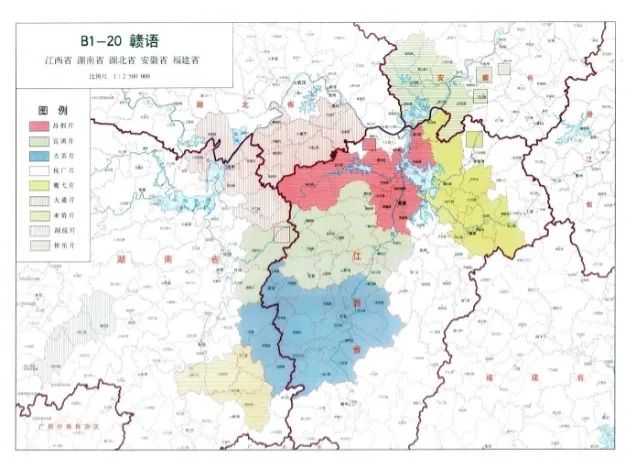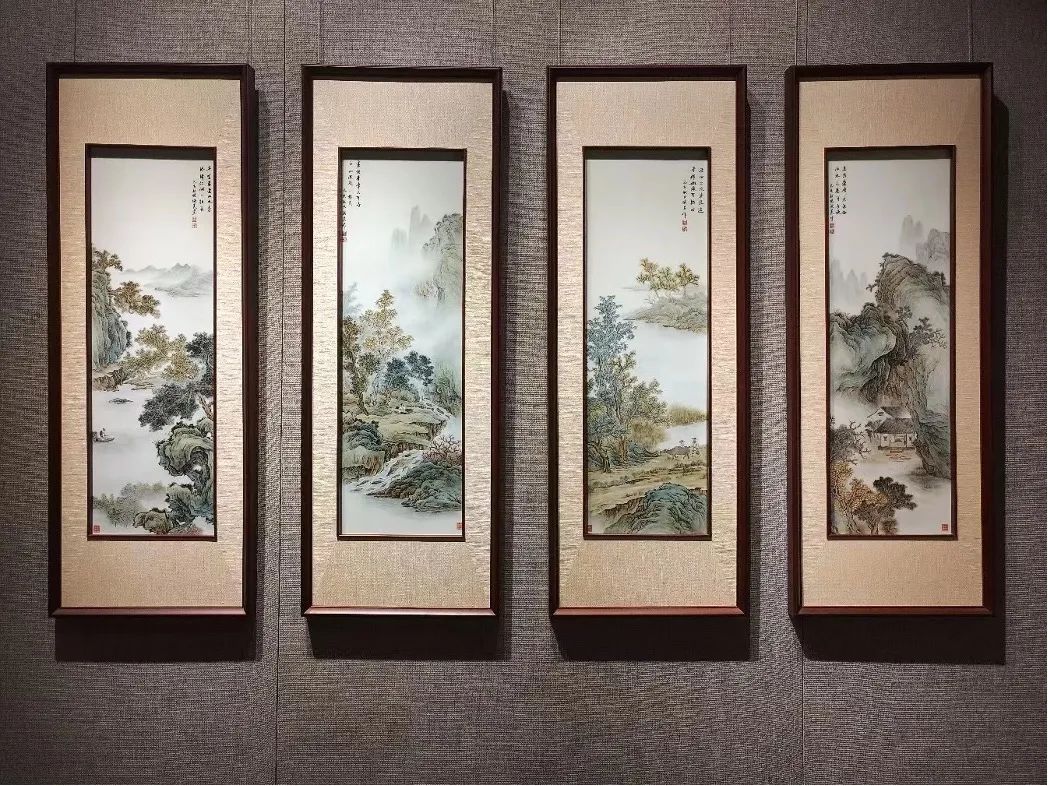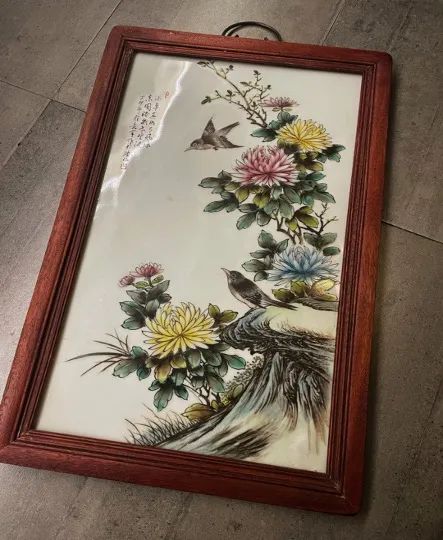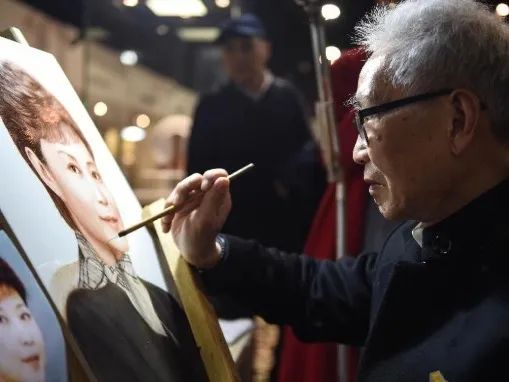赣语是汉语八大语系之一(Gan is one of the eight major members of the Chinese language family.),主要分布在江西境内以及鄱阳湖周边、湘东、闽西北、鄂东南、皖西南和湘西南等地区。江西省会南昌所使用的南昌话正是赣语中具有代表性的一支,广义上的南昌话则被称为赣语昌都片(Changdu Subgroup of Gan)[1],从两宋时期赣语人文格局形成算起,南昌话已有近千年历史。古老历史与文明的演进与发展,在这片土地上留下了丰富的非物质文化遗产,其中南昌瓷板画便属于那些巧夺天工的手工技艺中不可忽视的非遗珍宝。(The evolution of history and the development of civilization on this land have left behind a wealth of intangible cultural heritage, including Nanchang porcelain painting, an ingenious handicraft.)[2]

赣语分布图
摘自《中国语言地图集(第二版)》
本期“记忆的味道”将带领大家一同探寻赣文化,走进瓷板画的世界。
1. 引言
瓷板画,又称肖像画,瓷像,是江西特有的一种绘画艺术,主要流传分布在南昌市、景德镇、九江等邻近省市。它诞生于古都南昌,发源于中国传统绘画法、陶瓷彩绘,又融合了西方摄影元素,是绘画艺术与烧瓷工艺的巧妙结合,也是中华民族的艺术瑰宝和赣文化的代表。(It is a delicate combination of the arts of painting and porcelain firing, representing the gem of Chinese art and Gan culture.)

瓷板画这一名词产生于明代中期,常被镶嵌于门、柜、屏风之上作装饰效果,直到清代,陶瓷艺术走向极盛时期,烧瓷、绘瓷技艺都得到极大提升,瓷板画的发展随之走向繁荣。
2. 艺术特征
南昌瓷板画继承了中国传统绘画的精华,同时又兼容中国陶瓷艺术的特点。它不但可以画出逼真的摄影以及古典油画的效果,也能随心所欲地表现各种流派的艺术风格,具有浓郁的赣文化特点,在中国绘画史和国际绘画艺术上有极高的地位和影响。(It can channel the realistic styles of photography and classical oil painting, and in fact be creatively used to express any genre. Having a strong Gan cultural identity, it enjoys a high status in the history of Chinese painting and is influential even internationally.)

南昌瓷板画最大的特色是将我国传统的肖像画与西方的肖像创作和照相技术相结合。它的起源与肖像画密不可分,因此肖像瓷板画在南昌瓷板画作品中占有很大的比重。此外,瓷板画的题材还有花鸟虫鱼、历史纪实、宗教与民间故事等,题材丰富,内容多样。(The subjects of Nanchang porcelain painting range from natural beings, such as flowers, birds, insects and fish, to historical chronicles, including religious and folk tales.)与纸绢画相比,瓷板画的材料物理和化学性能更稳定,因此不怕潮湿、不怕霉变,其色彩能够保持鲜艳长达数十年之久。
3. 起源与发展
瓷板画最早可追溯到秦汉时期的帛画,真正意义上的“瓷板画”则出现在明代中期,从清朝中期开始,瓷板画的发展走向了兴盛。1892年,中国画家邓碧珊在中国传统瓷器彩绘的基础上,结合西方摄影术,开创了瓷上肖像画的艺术领域。民国初年,南昌人梁兑石在现今的南昌市中山路繁华地段开设了丽泽轩瓷庄,聘请艺人按顾客要求绘制肖像和粉彩瓷器,开创了瓷板画在南昌发展的先河。

新中国成立后,瓷板画艺人与香港摄影师仇永平联合创作,向世界各国推介南昌瓷板画,使其远销海外,奠定了南昌瓷板画的国际地位。(Collaborating with the Hong Kong photographer Sau Wingping, the porcelain artists started to share Nanchang porcelain painting with the world. Their products travelled and Nanchang porcelain painting began to be known internationally. )然而,由于瓷板画学艺时间长、难度大,瓷板画传至第六代,几年前一度出现后继无人的局面,好在南昌瓷板画第七代传承人的招收启事公布不久,就有不少爱好传统文化的年轻大学生慕名前来报名,继续传承这项历史悠久的手艺。
4. 制作工艺
瓷板画作为在平板素瓷上的陶瓷艺术品,烧制时最高温度可达1250℃左右,其制作时间周期长,制作工序较多且复杂,主要包括以下几个方面:
(1)做胚,用铁棍把泥巴滚成平面状,待半干后用刀子剪裁形状;(Forming: Firstly, roll the clay flat with an iron rod. After the clay is semi-dry, cut it with a knife.)
(2)进行陶瓷绘画,将各种颜色的釉料涂抹在素瓷板上,形成画幅,这是决定成败的关键一步;(Painting: Apply different colors of glaze to the plain porcelain flat. This is the most crucial step.)
(3)上釉,瓷板师傅用喷枪上一层透明釉,釉一定要均匀分布;(Glazing: Apply a layer of transparent glaze with a spray gun. The glaze must be evenly distributed.)
(4)进窑高温烧制,瓷板的烧制周期较长,一般为3至5天。(Heat the item to high temperatures in a kiln. This process generally takes three to five days.)

一幅瓷板画须经过少则十天多则数月才能完成,不仅需要精妙的画工,还要有高超的烧瓷技术,二者缺一不可。由于不同的陶瓷分类其吸水率不同,所以画师在画不同的画作时也需选用不同的陶瓷;同时,不同的瓷土所含杂质不同,去除杂质的过程尤其需要耐心和体力。在陶器上作画其实对绘画者的基本功要求更高,因而让许多画者望而却步,而能够坚持瓷板画创作和制作者,都为这张赣文化的名片投入了大量的心血。(Those who persist in making and creating porcelain paintings have put a lot of efforts in this embodiment of Gan culture.)
5. 结语
南昌瓷板画,源自景德陶瓷千年窑火,踏过数百年悠久历史,是江西传统民间艺苑中的一朵奇葩。瓷板画既传承了民族绘画传统的精华,又结合了中国陶瓷技艺,并且兼蓄西方绘画摄影特点,是在艺术历史中博采众长、推陈出新的工艺美术。
作为国家级非遗文化产品,瓷板画不仅沉淀了匠人创作的工艺技巧、艺术追求、纯粹心境,还饱含赣文化百年传承的烟火气息。传统艺术珍品南昌瓷板画,透过其精致的画幅彰显了赣文化深刻的历史内涵和江西民间艺术的旺盛生命力,值得我们当代青年人从中汲取传统文化蕴含的智慧和力量。(As a national intangible cultural heritage, Nanchang porcelain painting not only showcases the craftsmanship, artistic pursuit and purity of the mind of the artisans, but also serves as a witness of the hustle and bustle of the centuries-old legacy of Gan culture. Nanchang porcelain painting tells the story of the profound history of Gan culture and the vigorous vitality of Jiangxi folk art, through one exquisite piece after another, providing us with the traditional wisdom and power that we the new generation need.)
参考文献
[1] 南昌瓷板画研究中心简介[J]. 2013. 文艺生活(艺术中国), 903(04), 99-117.
[2] 南昌瓷板画研究中心. 2014.《南昌瓷板画透视》. 南昌: 江西美术出版社.
[3] 中国广播网《南昌瓷板画“申遗”入围 有望成为“非遗”》
http://news.sina.com.cn/s/2008-02-26/161313478778s.shtml
[4] 华夏经纬网 《国家级非物质文化遗产——瓷板画》
https://www.huaxia.com/c/2021/10/25/839068.shtml
部分资料来自于网络
我要评论 (网友评论仅供其表达个人看法,并不表明本站同意其观点或证实其描述)
全部评论 ( 条)